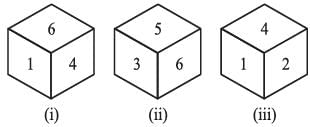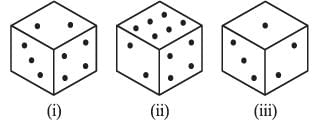Olympiad Test: Cubes and Dice - Class 10 MCQ
15 Questions MCQ Test - Olympiad Test: Cubes and Dice
A cube painted blue on all faces is cut into 27 small cubes of equal size. How many small cubes are painted on one face only?
A cube is painted red on all faces is cut into 27 small cubes of equal size then how many cubes are not painted on any face?
A cube of side 10cm is coloured green with a 2 cm wide red strip along all the sides on all the faces. The cube is cut into 125 smaller cubes of equal size then how many cubes are without any colour?
How many dots are there on the dice face opposite the one with three dots?

Three positions of a dice are given. Based on them find out which number is found opposite the number 2 in the given cube.

In the given figure find the number of dots on the face opposite the face having 3 dots.

Two positions of a dice are shown. When 4 is at the bottom, what number will be on the top?

In the given figure, when 4 is at the bottom, what number will be on the top?

Two positions of a parallelepiped are given below. When the number 3 will be on the top side then which number will be at the bottom?


Three different positions X, Y, Z of a dice are as shown below.

Which number lies opposite to 6?
In the given figure, which number lies at the bottom face in position B?

In the following figure, which symbol is opposite to the arrow.

Two positions of a block are given below. When 1 is at the top, which number will be at the bottom?

In the given figure, when 2 is at the bottom, what number will be at the top?

Cubes of same size are arranged in the form of cube on a table then a column of five cubes is removed from each of the four cubes is removed from each of the four corners. All the exposed faces of rest of the cube are coloured yellow. Then how many small cubes are there in the solid after the removal of the column?














